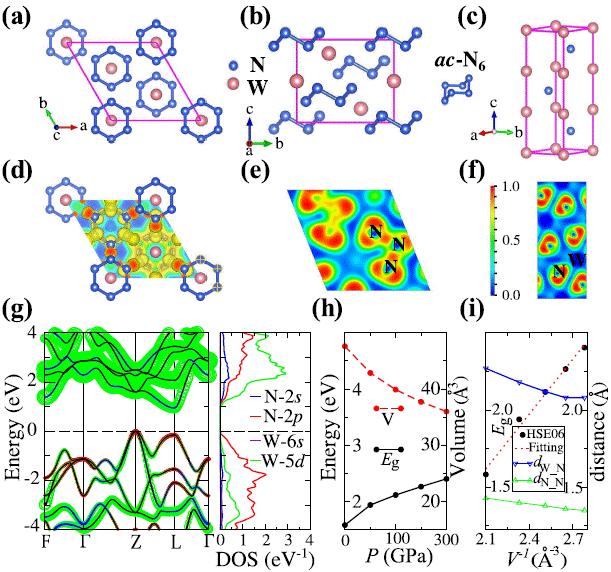Machine-learning predicted a superhard and high-energy-density tungsten nitride

Crystal structrure and theoretical electronic structures of new W-N phases. Credit: ©Science China Press
On the other hand, hybrid compounds of transition metals and light elements, especially transition metal nitrides have been widely studied for their high incompressibility and bulk modulus. However, superhard (Vickers hardness over 40 GPa) tungsten nitrides have not been found yet.
The energy bands contributed by d valence electrons of tungsten atoms can easily cross the fermi energy level, and the metallicity leads to great reduction of their hardness. Therefore, designing non-metallic tungsten nitride crystal structures seems be a promising way to reach outstanding mechanical properties, such as superhardness.
Based on previous researches, a collaborated research team led by Prof. Jian Sun and Prof. Hui-Tian Wang at Department of Physics, Nanjing University summarized three clues for designing superhard hybrid compounds of transition metal and light elements: the high-pressure stable and ambient-pressure metastable crystal structure, the non-metallic electronic structures, and a large ratio of light elements.
These clues inspired them to design nitrogen-rich tungsten nitrides containing special nitrogen-based basic configurations, such as rings, chains, networks and frameworks, etc. Based on these designing rules and newly developed machine-learning accelerated crystal structure search method, they have successfully predicted a non-metallic nitrogen-rich tungsten nitride h-WN6.
It has a sandwich-like structure, formed by nitrogen armchair-like six-membered ring and tungsten atoms. The electron localization function and Bader charge analysis indicate that h-WN6 is an ionic crystal containing strong N-N covalent bonds. It can be stable at high pressures and metastable at ambient pressure.
Moreover, it has a small indirect energy-gap and abnormal gap broadening behavior under compression. (see the crystal structure, electronic structures and the high pressure behaviors in the attached Figure) More interestingly, h-WN6 is estimated to be the hardest among transition metal nitrides known so far, with a Vickers hardness around 57 GPa and also has a pretty high melting temperature of around 1,900 K. Moreover, their calculations also show that this nitrogen-rich compound can be considered as a potential high-energy-density material because of the good gravimetric (3.1 kJ/g) and volumetric (28.0 kJ/cm3) energy densities.
Their work developed a machine learning accelerated crystal structure search method, summarized the designing rules of superhard transition metal light elements compounds, and predicted a superhard and high-energy-density tungsten nitride with good thermal stability. It will stimulate the theoretical design and experimental synthesis of this kind of transition metal materials with potential application value. This will also enrich the family of superhard materials and may be used a reference for understanding the origin of hardness.
###
This work was supported by the Ministry of Science and Technology of the People's Republic of China (2016YFA0300404 and 2015CB921202), the National Natural Science Foundation of China (51372112 and 11574133), the NSF of Jiangsu Province (BK20150012), the Fundamental Research Funds for the Central Universities, the Science Challenge Project (TZ2016001) and Special Program for Applied Research on Super Computation of the NSFC-Guangdong Joint Fund (the second phase) (U1501501).
See the article:
Kang Xia, Hao Gao, Cong Liu, Jianan Yuan, Jian Sun, Hui-Tian Wang, Dingyu Xing, A novel superhard tungsten nitride predicted by machine-learning accelerated crystal structure search, Science Bulletin, 2018, Vol. 63, No. 13: 817-824 https:/
Media Contact
More Information:
http://dx.doi.org/10.1016/j.scib.2018.05.027All latest news from the category: Materials Sciences
Materials management deals with the research, development, manufacturing and processing of raw and industrial materials. Key aspects here are biological and medical issues, which play an increasingly important role in this field.
innovations-report offers in-depth articles related to the development and application of materials and the structure and properties of new materials.
Newest articles

First-of-its-kind study uses remote sensing to monitor plastic debris in rivers and lakes
Remote sensing creates a cost-effective solution to monitoring plastic pollution. A first-of-its-kind study from researchers at the University of Minnesota Twin Cities shows how remote sensing can help monitor and…

Laser-based artificial neuron mimics nerve cell functions at lightning speed
With a processing speed a billion times faster than nature, chip-based laser neuron could help advance AI tasks such as pattern recognition and sequence prediction. Researchers have developed a laser-based…

Optimising the processing of plastic waste
Just one look in the yellow bin reveals a colourful jumble of different types of plastic. However, the purer and more uniform plastic waste is, the easier it is to…



